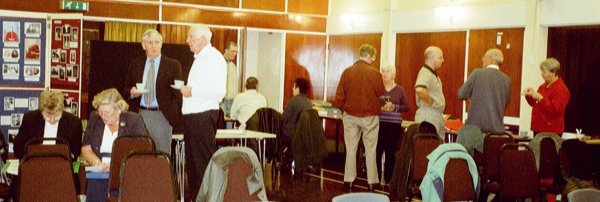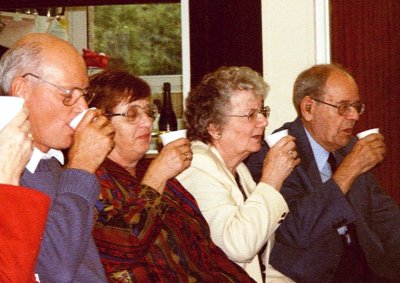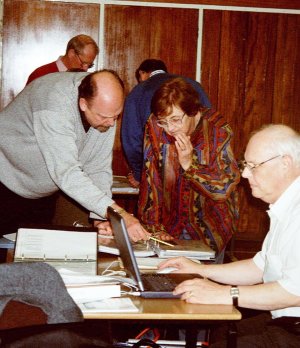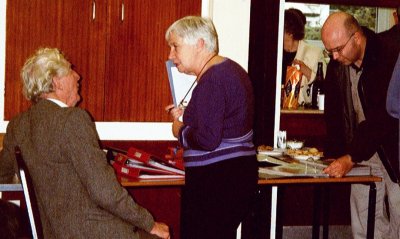

2001 Conference - Chairman's Annual Report
and Photographs
By Bob Solly
This article was originally published in the December 2001 edition of Soul Search, the journal of The Sole Society.
Introduction
In 1987 Fred and June Sole were visited by two friends from the USA. They had traced a connection to a one-time monk in Cambridgeshire in the 15th century. Having assisted in a small way, Fred and June became interested in their family histories.
The Sole Society was formed and began on 2 November 1991.
Its objectives:
“To promote and engage in comprehensive world-wide research into the genealogy and family history of families carrying the surnames of Sole, Saul, Sewell and Solley.
To promote and engage in any aspect of the study of Genealogy, Family History and Local history that may further such research.
To promote the preservation, security and accessibility of all archival material.”
By 31st December there were 41 members including the committee
Pauline Saul - Chairman
Fred Sole - Secretary and Sole
John Sole - Editor
Don Steel - Research and Sole
David Parsons - Chairman and Treasurer
Bill Soles - Soles
Rosemary Bailey - Saul
Elizabeth Hughes - Solley
Geoff Sewell - Sewell
Anna Pye - Profiles
Unfortunately Don has to attend a family history fair today; he was disappointed not to be here to celebrate with us. I was hoping he would give us his lecture on the origin and potential connections of the various names in which we are interested.
I am sure many of you will have read the articles in the Sole Society journal – I have some copies for anyone that might not have seen it.
Background
Don had already been researching the origin of the Sole name. He had already established a number of variations in the spelling of the name such as Sole, Soul, Soal
He also concluded that there were possible connections with other similar names – these were established as Saul, Sewell and Solley.
A substantial volume of work had been produced in Maine, USA and published in 1926 by the Reverend G T Ridlon. This was entitled “A contribution to the History, Biography and Genealogy of the families named Sole, Solly, Soule, Sowle, Soulis with other forms of spelling....” The 1151 pages and two volumes represented 10 years’ work (we have a copy here if anyone wants to inspect it). It began when Ridlon was a correspondent for a local weekly newspaper and was approached by James Soule of Portland to collect “the general history and statistics” of the families descended from George Soule who was one of the Pilgrim Fathers on the Mayflower. Don’s view was that although the earlier historical background (Vikings and Normans, and an ancestor who came with the Conqueror) was nonsense, the more recent material seemed reasonably sound. It does form the basis of a substantial part of the earlier details we have (particularly on the Solley’s)
A copy had been obtained by Don and this, along with his own experience, formed the basis for his thesis published in volume 1 of the journal.
So on All Saints’ Day 1991 (2nd November), The Sole Society was established as a one-name society.
The other members had a substantial amount of information on their own families, which they agreed to share with all members.
It was agreed that a regular journal be published and the first journal was generously compiled by Janet Hurst, at that time editor of the Cambridgeshire Family History Society. John Sole was elected editor for subsequent issues.
The first edition was distributed to about 60 members and Fred undertook to search through various telephone directories and promote the Society with a mailshot.
Early Days
Fred had already done a considerable amount of work extracting and collating Sole (and Soul) information.
Don had developed a coding system for manual charts developed from his experience with another one name society (BROOKING) and had drawn up charts using early records for Sole and Solley.
Geoff Sewell had arranged to download all the IGI information on our names, using the Soundex system, where names are sorted based upon similar sounding names (even though in a traditional alphabetical list they would not appear together).
He was able to convert this into a database (no small achievement given the development of computers at that time) and this formed the basis of a talk that he has given to a number of Family History Societies – “Thirty-Thousand Soles saved”.
Elizabeth had obtained many details of early Solleys. including information from wills and had produced manual charts. an early contact had provided a substantial family tree going back to the 1400’s – again in manual form.
Disks of the IGI records of each name were circulated to the newly appointed co-ordinators.
John Slaughter joined in 1992 and became active in the pursuit of Saul trees, become the project co-ordinator. I also joined then, taking on the tack of updating the computerising of Solley records (as auditor initially, then treasurer).
Maureen and Tony Storey became active in the further computerisation of Sole information
New members continued to be recruited but no real critical mass was reached. The committee struggled to get the journal published on time and one issue became a list of members’ interests – this did not generate any new links with existing families. It was then agreed that members interests were not relevant in our journal as we were all interested in the same names.
By 1993 the journal had developed, but many of the articles were co-ordinators’ reports and John Sole was appealing for more general articles.
Development of the Society
From the discussions of the committee, it became clear that more information had to be put onto computer from Don’s manual charts, the IGI and members’ personal records.
After a number of committee meetings (these are held on a quarterly basis alternating between the committee members’ homes) each name co-ordinator was working using their own favoured program.
One of the key tenets of our Society is that we are adding data from any source and are not just interested in our own family histories (although, of course, that was what motivated us originally to join), but also happy to contribute to the infinitely broader task of assembling the history of the surname as far back (and forward) as possible.
Annual General Meetings and One Day Conferences.
The first AGM in 1992 was held in Olney and since then the meeting has developed into today’s format, where the society is able to bring in distinguished independent speakers to ensure that the whole day is enjoyable and productive.
Various venues have been tried:
Olney, Buckinghamshire - once
Nuneaton - twice
Houghton Regis, Bedfordshire - four times
Cobham, Surrey - once
Oxshott, Surrey - twice
Those members who do come have found the conference enjoyable and it gives them a chance to meet others to exchange information about their common ancestors.
Publications
The journal continued to develop, including interesting articles from committee members. John Sole, the editor had a success in the Elizabeth Simpson Award Competition - Highly Commended - in the 1993/4 competition. (journal 4)
Subsequently, however, pressure of work for John Sole meant that he was unable to achieve the Society’s requirement of three issues a year.
At the same time, we had found that the number of enquiries generated through the internet had increased enormously (the first thing most people do when using a search engine is to type in their surname and see what happens).
Tim Soles has been instrumental in single handed developing our web presence and the Society owe him special thanks for all the work he has put in. It was natural, with his computer skills and capacity for hard work, that he should volunteer to take over as Editor of the journal in January 2000. The journal has been stuffed full of interesting articles and the co-ordinators’ reports have revealed the tremendous amount of work being done by an increasing number of members.
As you will see in the latest edition, being awarded a commendation in the Elizabeth Simpson awards (5th place and the smallest society) which covers all family history societies as well as one-name and single interest societies. We also came second in the Guild of One Name Societies award. Congratulations.
Family History and Computers
After looking at the various programmes in use including my own chosen US program called Reunion and after some investigation – I felt that the available capacity and the combined tree making program were more suited to the large volumes of data being handled by our society.
Bob Sheldon tried the programme, laboriously converting his own data from both spreadsheet and manual details and gave his approval. At the next committee meeting we approved the use of Reunion. Later this was revised – after a takeover of the business by a large US corporation – and is now Generations – Grand Suite.
Actually bigger is not necessarily better and to obtain the correct version of the software we have to buy about 12 CDs which have lots of useful US date – such as a list of names from the US social security numbers and a program to record your grandmother’s recipes. Not too useful.
The other surname co-ordinators also obtained the program and started the transfer from manual records with enthusiasm.
Tony and Maureen attacked the Sole records with an enthusiasm that left the other co-ordinators gasping. John Saul was working on the Sauls and I had completed the deletion of all duplication on the IGI list for Solleys and input large amounts on information from Ridlon and other sources (such as those from George Solly).
However the Sewells were being left behind. As research co-ordinator Tony felt that as the largest surname group (as indicated by the IGI list) more members should be involved. At the same time in 1998 he proposed to the committee that a new research standard be published to make our objectives and success more measurable.
The objectives are to have all IGI entries readily available; to provide family charts from groups identified from the IGI and members’ contributions; to extract and record all GRO entries from 1837 onwards; to extract details from the 1881 Census; and to make computer records of all the information.
That we have been so successful has been due to the committee members, the co-ordinators and their helpers and not least to Tony in ensuring that they are well organised in their work. In particular Tony and Maureen put in a great deal of work recording Sewell names.
Conclusion
From small and lowly beginnings, it is clear that The Sole Society is the now the most knowledgeable about the origins of our names and it is where many people visit as their first port of call.
Membership has grown, but not as fast or as continuously loyal as we might have hoped. Many who contact us only have a passing interest about their ancestor with one of our names and, somewhat understandably, once they have found what they need, they can close that branch of their family tree.
We have not yet really tapped the untold numbers of people with our names (or their parents) and the next ten years hold challenges for the society if it is not supported by more than the dedicated committee members and those who work as surname co-ordinators.
Below are some photos of the tenth anniversary Annual Gathering

Over a cup of tea members discuss their research

Members celebrate with a champagne toast

The Solly members get their heads together in the workshop session. From left to right: George Solly, Elizabeth Hughes and Bob Solly

Sewell members in discussion (from the left: Warren Sewell, Diana Kennedy & Ian Sewell)